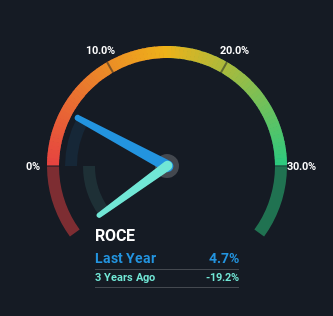- Hong Kong
- /
- Personal Products
- /
- SEHK:3332
Nanjing Sinolife United (HKG:3332) Might Have The Makings Of A Multi-Bagger

What trends should we look for it we want to identify stocks that can multiply in value over the long term? Typically, we'll want to notice a trend of growing return on capital employed (ROCE) and alongside that, an expanding base of capital employed. Basically this means that a company has profitable initiatives that it can continue to reinvest in, which is a trait of a compounding machine. Speaking of which, we noticed some great changes in Nanjing Sinolife United's (HKG:3332) returns on capital, so let's have a look.
What Is Return On Capital Employed (ROCE)?
For those that aren't sure what ROCE is, it measures the amount of pre-tax profits a company can generate from the capital employed in its business. To calculate this metric for Nanjing Sinolife United, this is the formula:
Return on Capital Employed = Earnings Before Interest and Tax (EBIT) ÷ (Total Assets - Current Liabilities)
0.047 = CN¥19m ÷ (CN¥460m - CN¥64m) (Based on the trailing twelve months to June 2023).
Therefore, Nanjing Sinolife United has an ROCE of 4.7%. In absolute terms, that's a low return and it also under-performs the Personal Products industry average of 10%.
Check out our latest analysis for Nanjing Sinolife United

Historical performance is a great place to start when researching a stock so above you can see the gauge for Nanjing Sinolife United's ROCE against it's prior returns. If you'd like to look at how Nanjing Sinolife United has performed in the past in other metrics, you can view this free graph of Nanjing Sinolife United's past earnings, revenue and cash flow.
So How Is Nanjing Sinolife United's ROCE Trending?
We're delighted to see that Nanjing Sinolife United is reaping rewards from its investments and has now broken into profitability. While the business is profitable now, it used to be incurring losses on invested capital five years ago. Additionally, the business is utilizing 47% less capital than it was five years ago, and taken at face value, that can mean the company needs less funds at work to get a return. This could potentially mean that the company is selling some of its assets.
Our Take On Nanjing Sinolife United's ROCE
In the end, Nanjing Sinolife United has proven it's capital allocation skills are good with those higher returns from less amount of capital. Since the stock has only returned 30% to shareholders over the last five years, the promising fundamentals may not be recognized yet by investors. So exploring more about this stock could uncover a good opportunity, if the valuation and other metrics stack up.
If you'd like to know more about Nanjing Sinolife United, we've spotted 2 warning signs, and 1 of them shouldn't be ignored.
While Nanjing Sinolife United may not currently earn the highest returns, we've compiled a list of companies that currently earn more than 25% return on equity. Check out this free list here.
If you're looking to trade Nanjing Sinolife United, open an account with the lowest-cost platform trusted by professionals, Interactive Brokers.
With clients in over 200 countries and territories, and access to 160 markets, IBKR lets you trade stocks, options, futures, forex, bonds and funds from a single integrated account.
Enjoy no hidden fees, no account minimums, and FX conversion rates as low as 0.03%, far better than what most brokers offer.
Sponsored ContentValuation is complex, but we're here to simplify it.
Discover if Nanjing Sinolife United might be undervalued or overvalued with our detailed analysis, featuring fair value estimates, potential risks, dividends, insider trades, and its financial condition.
Access Free AnalysisHave feedback on this article? Concerned about the content? Get in touch with us directly. Alternatively, email editorial-team (at) simplywallst.com.
This article by Simply Wall St is general in nature. We provide commentary based on historical data and analyst forecasts only using an unbiased methodology and our articles are not intended to be financial advice. It does not constitute a recommendation to buy or sell any stock, and does not take account of your objectives, or your financial situation. We aim to bring you long-term focused analysis driven by fundamental data. Note that our analysis may not factor in the latest price-sensitive company announcements or qualitative material. Simply Wall St has no position in any stocks mentioned.
About SEHK:3332
Nanjing Sinolife United
An investment holding company, engages in the manufacture and sale of nutritional supplements in the People’s Republic of China, Australia, New Zealand, and internationally.
Flawless balance sheet with questionable track record.
Market Insights
Community Narratives



